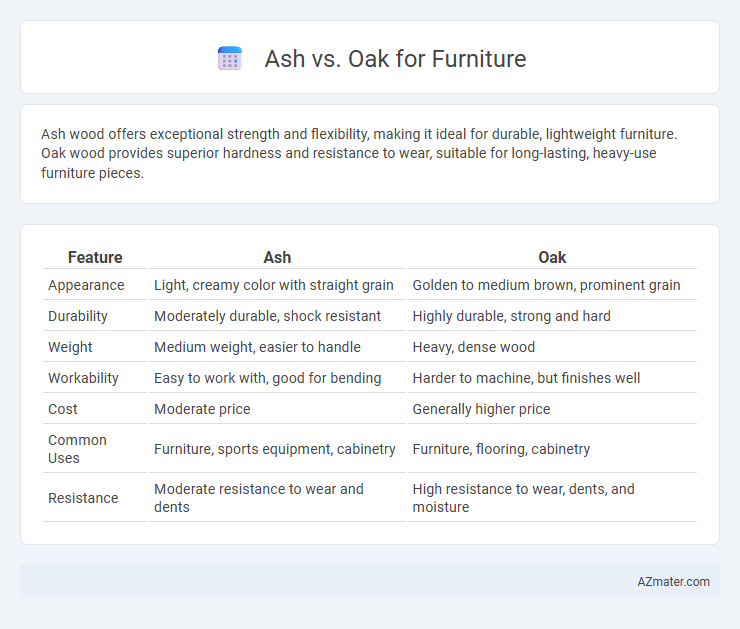Ash wood offers exceptional strength and flexibility, making it ideal for durable, lightweight furniture. Oak wood provides superior hardness and resistance to wear, suitable for long-lasting, heavy-use furniture pieces.
Table of Comparison
| Feature | Ash | Oak |
|---|---|---|
| Appearance | Light, creamy color with straight grain | Golden to medium brown, prominent grain |
| Durability | Moderately durable, shock resistant | Highly durable, strong and hard |
| Weight | Medium weight, easier to handle | Heavy, dense wood |
| Workability | Easy to work with, good for bending | Harder to machine, but finishes well |
| Cost | Moderate price | Generally higher price |
| Common Uses | Furniture, sports equipment, cabinetry | Furniture, flooring, cabinetry |
| Resistance | Moderate resistance to wear and dents | High resistance to wear, dents, and moisture |
Introduction to Ash and Oak Woods
Ash wood, known for its light color and prominent grain patterns, offers excellent shock resistance and durability ideal for furniture making. Oak wood, available in red and white varieties, features a dense grain with natural resistance to wear and moisture, making it a preferred choice for long-lasting, sturdy furniture pieces. Both woods provide distinct aesthetics and strong structural qualities, catering to various design preferences and functional needs.
Key Differences Between Ash and Oak
Ash wood offers a lighter color and more pronounced grain patterns compared to oak, making it ideal for modern and Scandinavian-style furniture. Oak is denser and harder, providing superior durability and resistance to wear, which suits traditional and high-traffic furniture pieces. Both woods are strong, but ash is more flexible, allowing easier shaping and lending itself well to curved furniture designs.
Appearance and Grain Patterns
Ash wood features a light, creamy color with straight, uniform grain patterns that offer a clean and modern aesthetic ideal for contemporary furniture designs. Oak wood exhibits a more pronounced grain with rich, varied textures and a range of hues from light tan to deep brown, providing a classic and rustic appeal. The open grain of oak creates a distinctive, tactile surface, while ash's smoother grain lends itself to minimalist and sleek finishes.
Strength and Durability Comparison
Ash wood is renowned for its impressive strength-to-weight ratio, making it a durable choice for furniture that withstands heavy use and pressure. Oak, particularly white oak, offers superior hardness and resistance to wear, ensuring longevity and structural integrity in furniture pieces. Both woods excel in durability, but oak's higher density and stiffness generally provide enhanced resilience against dents and scratches compared to ash.
Workability for Furniture Making
Ash wood offers excellent workability with its straight grain and moderate hardness, making it easy to cut, shape, and sand for furniture making. Oak, while harder and denser, provides a sturdy structure but can be more challenging to work with due to its coarse grain and tendency to splinter. Both woods finish well, but ash allows for smoother detailing and quicker machining, ideal for intricate furniture designs.
Finish and Staining Results
Ash furniture features a light, uniform grain that accepts stains evenly, allowing for smooth, consistent finishes ideal for modern and rustic designs. Oak's pronounced grain and porous texture produce a rich, textured finish when stained, enhancing its natural patterns with depth and warmth. Both woods offer excellent durability for furniture, but ash provides a cleaner, more uniform surface for staining, while oak yields more character and variation in color.
Cost and Availability
Ash wood offers a cost-effective option for furniture due to its widespread availability across North America and Europe, making it generally less expensive than oak. Oak, prized for its durability and grain pattern, tends to command higher prices because of its slower growth rate and limited supply in certain regions. Both hardwoods present excellent durability, but ash furniture typically provides better value in terms of initial investment and accessibility.
Environmental Impact and Sustainability
Ash wood, sourced from fast-growing trees, offers a sustainable option for furniture with its high recyclability and biodegradability, while also sequestering carbon effectively during growth. Oak, although durable and long-lasting, has a slower growth rate, making it less renewable and contributing to greater environmental strain when harvested extensively. Choosing ash over oak can reduce deforestation impacts and promote a more sustainable supply chain in the furniture industry.
Best Uses for Ash Furniture
Ash wood is highly favored for furniture due to its strength, flexibility, and attractive grain, making it ideal for chairs, tables, and cabinetry that require durability and aesthetic appeal. Its shock resistance and light color make it suitable for both traditional and contemporary designs, particularly in pieces subject to heavy use like dining chairs and office furniture. Ash also finishes well with stains and varnishes, enhancing its natural beauty while providing long-lasting protection.
Best Uses for Oak Furniture
Oak furniture is ideal for heavy-use items like dining tables, dressers, and cabinetry due to its exceptional hardness and durability. Its dense grain pattern and resistance to wear make oak perfect for living room pieces and flooring that require long-lasting structural integrity. Oak's natural strength and moisture resistance ensure furniture maintains form and finish, making it a superior choice for heirloom-quality and outdoor pieces.

Infographic: Ash vs Oak for Furniture
 azmater.com
azmater.com